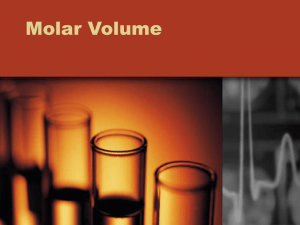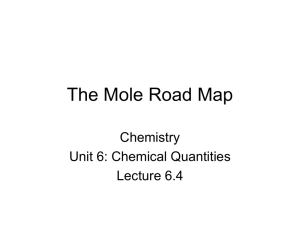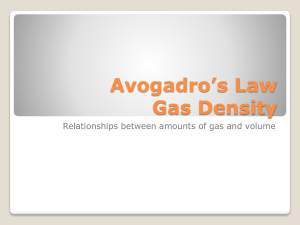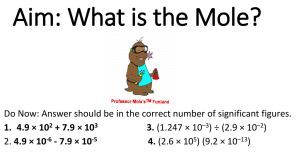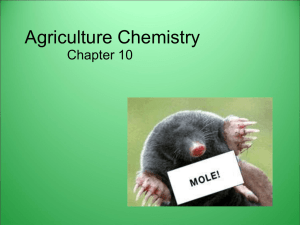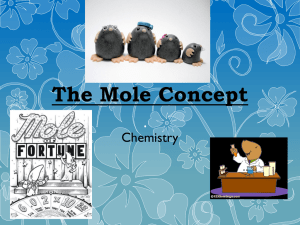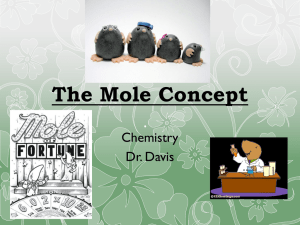File
advertisement
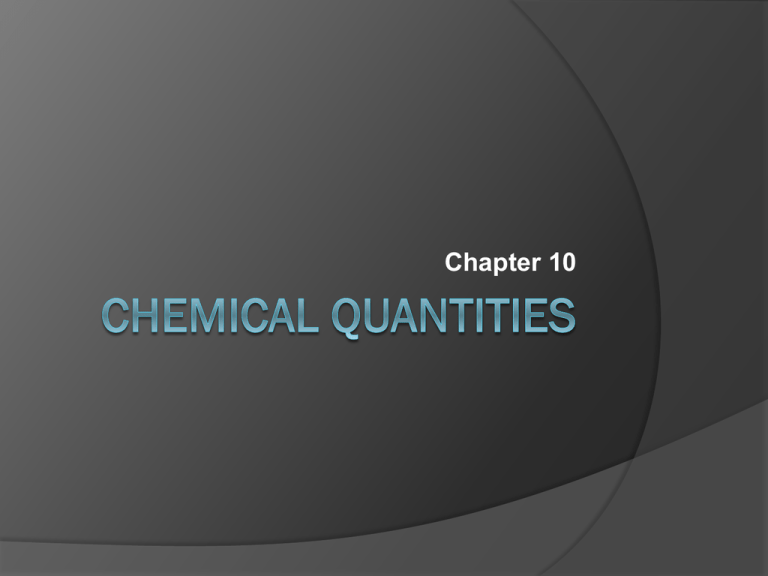
Chapter 10 What are practical ways to measure a container full of sand?? Mass Volume How many (Count) Matter is generally measured in one of three ways: By count: 1 dozen apples = 12 apples By mass: 1 dozen apples = 2.0 kg of apples By volume: 1 dozen apples = .20 bushels of apples Converting units If you know how count, mass, and volume relate to each other, you can do conversions between them. EX: How many bushels of apples are in 32.7 kg of apples? The MOLE It is not practical to individually count out small objects like sand grains, so instead we use a value that represents a larger quantity Ex: 120 eggs = 10 dozen eggs The MOLE Atoms, molecules, and ions are extremely small, so chemists use a unit similar to a “dozen” to measure a specific number of particles. The MOLE A MOLE is 6.02 x 1023 representative particles of whatever is being talked about ○ Avogadro's number = 6.02x1023 ○ Representative particles refer to the type of substance that you are talking about ○ Abbreviated mol Examples of Representative Particles Substance A balloon full of Neon A cup full of Water A spoon full of NaCl Representative Particle Neon Atoms Water Molecules NaCl Formula Units Number of Iron ions in Water Fe Ions How much oxygen is in the air O2 molecules Measuring by Count If you know the number of moles of something or how many particles of something there are, you can convert to the other. Ex: How many moles of magnesium are there in 1.23 x 1023 atoms of magnesium? Measuring by Count Ex: How many atoms are in 1.22 mol of Iron? *Measuring by Count Ex: How many atoms of carbon are in 3.21 mol of C8H18? Homework Pg. 296 # 10, 13, 14, Pg. 315 # 49, 52, Measuring by Mass The mass of a mole of atoms of a given element will always be the same. It equals the atomic mass expressed in grams Molar Mass: the mass of one mole of a given particle (atom, compound, etc.) Finding Molar Mass (Important notes below…write this down) Find the element; Find the molar mass; Multiply by the number of atoms of that element; Write this number down; Repeat for each element; Take the sum. Finding Molar Mass C: C: 1 x 12.00g = 12.00 g/mol C O2: O: 2 x 16.00 g = 32.00 g/mol O2 H2O: H: 2 x 1.01 g = 2.02 g H O: 1 x 16.00 g = 16.00 g O 18.02 g/mol H2O Finding Molar Mass C12H22O11: C: 12 x 12.01g = 144.12 g C H: 22 x 1.01g = 22.22 g H O: 11 x 16.00g = 176.00 g O 342.34 g/mol C12H22O11 Measuring by Mass If you know how many moles of a substance you have, you can find its total mass using the molar mass of that substance. Ex: What is the mass of 2.42 mol of H2O? = 43.6 g H2O Your turn! Measuring by Mass If you are given the mass, you can also find the number of moles Ex: How many moles are there in 227.4 g of Na2CO3? 106.0 g/mol Na2CO3 Measuring by Volume The volume of 1 mole of a solid and liquid are very different depending on the substance However, the volume of one mole of a gas is equal for every gas at the same physical conditions Avogadro’s Hypothesis Equal volumes of gases at the same temperature and pressure contain equal number of particles. Even though particles are different sizes, they still occupy the same amount of space because there is a great deal of space between gas particles Standard Temperature and Pressure In order to compare the volume of a gas to one mole of the gas, we must define the temperature and pressure As Temp goes up, Volume goes up As Volume goes down, Pressure goes up Standard Temperature and Pressure Standard Temperature and Pressure (STP): temperature of 0 ˚C and a pressure of 1 atm STP is used as a universal standard at which we compare things Measuring by Volume At STP one mole of a gas occupies 22.4 L of space Ex: How many moles of oxygen (O2) would be present in a 63.2 L container at STP? Practice How many moles are present in a sample of 4.02 x 1024molecules of NH3? What is the mass of 2.14mol of C2H4O2? How many molecules can be found in 3.42mol of BaSO4? Practice makes perfect Under STP, what volume does 4.95mol of CH4 take up? If a gas takes up 34.71L of space under STP, how many moles of that gas is present? How many moles are present in a 134g sample of HBr? Mo’ Practice = Mo’ Perfect How many cookies are in 24.1moles of Oreo’s? How many/much _________ can be found in __________ while under STP? Quiz Practice HCl CO2 Quiz Practice How many moles are in 4.03 𝑥 1022 molecules of silver (I) oxide? 22 4.03 𝑥 10 𝑎𝑡𝑜𝑚𝑠 𝐴𝑔2 𝑂 =0.0669 𝑚𝑜𝑙𝐴𝑔2 𝑂 1𝑚𝑜𝑙 6.02 𝑥 1023 = Quiz Practice How much mass does 3.79 moles of 𝐵𝐹3 have? B: 10.8 x 1=10.8g F: 19.0 x 3= 57.0g Total: 67.8g 67.8𝑔 1𝑚𝑜𝑙 3.79 𝑚𝑜𝑙 = 257.0g 𝐵𝐹3 = Quiz Practice Quiz Practice How much volume in liters does 6.307 moles of NaCl fill at STP? 22.4𝐿 1𝑚𝑜𝑙 6.307𝑚𝑜𝑙 141𝐿 NaCl = Quiz Practice How much mass does 1.805 moles of Lithium Bromide (LiBr) have? Li: 6.9 x 1= 6.9g Br: 79.9 x 1= 79.9g Total= 86.8g 1.805𝑚𝑜𝑙 = 86.8𝑔 1𝑚𝑜𝑙 156.7𝑔 𝐿𝑖𝐵𝑟 1 𝑚𝑜𝑙 = Mixed Mole Conversions We now know: 1 mole = 6.02 x 1023 particles = molar mass = 22.4 L of gas at STP Because of this, we can convert from count, mass, or volume to count mass or volume. BUT, you must first convert to moles Mixed Mole Conversions Practice! CO2 Practice, part dos! Ugh, More? Practice?? Even more practice??? (mind=blown) And I thought my mind was already blown… Practice Extraordinaire! What is the mass of 3.72 x 1024 molecules of C3H8? 3.72 x 1024 molecules =273g C3H8 1mol 44.11g 6.02 x 1023 molecules 1mol To practice or not to prac… well let’s just practice What is the volume of 57.9g of methane CH4 gas at STP? 57.9g = 80.8L CH4 1mol 22.4L 16.05g 1mol Oh the practice! What is the mass of 1.5 x 1025 molecules of CO2? 1.5 x 1025 molecules 1mol 44.01g 6.02 x 1023 molecules 1mol = 1097g CO2 = 1.10 x 103g CO2 Percentages Matter! Fertilizers Higher nitrogen content greener grass Higher potassium content stronger roots A man walks into a restaurant…. Percent Composition The percent by mass of each element in a compound Usually used to determine the chemical experimentally If the formula is known, the percent can be easily determined from each atom’s molar mass Percent Composition Ex: What is the percent composition of H 2O H: 2 x 1.01 g = 2.02 g O: 1 x 16.00 g = 16.00 g 18.02 g H2O % H = 2.02 g / 18.00 g x 100 = 11.2 % H % O = 16.00 g / 18.00 g x 100 = 88.79% O Percent Composition Ex: CH2Cl2 C: 1 x 12.01 g = 12.01 g H: 2 x 1.01 g = 2.02 g Cl: 2 x 35.45 g = 70.90 g 84.93 g CH2Cl2 % C = 12.01 g / 84.93 g x 100 = 14.14 % C % H = 2.02 g / 84.93 g x 100 = 2.38 % H % Cl = 70.90 g / 84.93 g x 100 = 83.48 % Cl Yes-sir-ee Bob! What is the percent composition of NaOH? Na: 23.0g x 1 = 23.0g O: 16.0g x 1 = 16.0g H: 1.0g x 1 = 1.0g Total: 40.0g Na: 23.0/40.0 x 100 = 57.5% O: 16.0/40.0 x 100 = 40.0% H: 1.0/40.0 x 100 = 2.5% Ah-Yea-ah!! What is the percent composition of 𝑀𝑔(𝑁𝑂3 )2 ? Mg: 24.3g x 1 = 24.3g N: 14.0g x 2 = 28.0g O: 16.0g x 6 = 96.0g Total: 148.3g Mg: 24.3g/148.3g x 100 = 16.4% N: 28.0g/148.3g x 100 = 18.9% O: 96.0g/148.3g x 100 = 64.7% Bubblegum and Magic Cards! Empirical Formula The ratio of atoms in a compound NOT the chemical formula! Calculating the Empirical Formula from Percent Composition 1. 2. 3. 4. 5. Assume you have 100 g of the compound. Change “%” to “g” Convert grams to moles for each element Divide each mole amount by the smallest mole amount, these numbers are the coefficients for the E.F. If the numbers from step 4 are not all whole numbers, multiply the step 4 numbers by a whole number so all step 4 numbers are whole numbers .5 moles x 2 .333 moles x 3 .25 moles x 4 .20 moles x 5 Empirical Formulas Ex: A compound is determined to be 26.56% K, 35.41% Cr, and 38.08 % O. What is the empirical formula of the compound? Molecular Formula of a Compound Molecules can have formulas that are not the simplest ratio. They can be whole number multiples of the Empirical Formula Calculating Molecular Formula 1. 2. 3. Start with the E.F. Determine molar mass of E.F. Divide the molar mass of the unknown molecule by the molar mass of the E.F. This tells how many E.F.’s are in the M.F 4. Multiply the subscripts of the E.F. by the number found in step 3 Molecular Formulas Ex: What is the molecular formula of a compound that has an empirical formula of P2O5 and a molar mass of 283.89 g? P: 2 x 31.0g = 62.0 g O: 5 x 16.0g = 80.0 g 142.0g P2O5 283.89g =1.999 ≈ 2 therefore, MF=P4O10 142.0g
